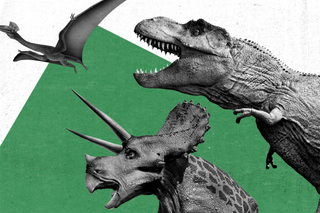
Our Enduring Love for Dinosaurs, Explained
Dinosaurs appeal to something innate in the human psyche — happiness, excitement, fear, sadness, and good old child-like wonder.

There is something wonderful and bewildering in equal measure about the horned crocodile-faced hell heron. This is a new dinosaur species, one of the two new dinosaur species scientists found this week in the U.K. The other sounds more benign, it’s named the “Milner’s riverbank hunter.” Scientists discovered the fossils in the Isle of Wight — commonly known as the Dinosaur Island.
Everything about this seems right out of a storybook. This by no means is the first new dinosaur species discovered (there are about 700 species discovered to date), and will definitely not be the last. But each fossil, each lingering bone carries an unblemished novelty and intrigue. Something about dinosaurs triggers a spark in the eye and the lips instinctively curve into a smirk. There’s no stopping it.
“If museums of natural history are temples to science, dinosaurs are their shrines,” a writer remarked. Our longstanding love affair with dinosaurs is a healthy mix of ideological allure, scientific innovation — and good marketing.
The dinosaur appeals to something innate in the human psyche. National Geographic ventured a guess: Maybe it is the joy of finding a long-dead creature. Or the thrill of unraveling the mysteries of a forgotten species. Maybe it’s the terror and authority wielded by an animal that only an asteroid could kill. Or, it’s the narrative of tragedy — of a world lost, of a species extinct. Happiness, excitement, fear, sadness.
Researchers have described dino-curiosity as an “intense interest.” A possible explanation is it grips the human consciousness very early on, when we’re children and in pursuit of absolute wonder. Child psychologist Sheldon White captured the appeal of dinosaurs in three words: “big, fierce, and extinct.” Many kids go through “dinosaur phases,” where they can roll names of several species and periods right off the tongue. Psychologically, this hyper fixation is also called “imagination-based play.”
But this play is inextricably tied to children’s identity. Infants don’t have a sense of “self” in the first year of life. It is only between 1.5 and three years of age when children come to develop consciousness. They are befuddled by the world around them. They are outside the culture and basic expectations of society. When they turn three, this “self” is ready to be sculpted. “Children then embark on this journey of creating this thing called ‘self,’ and one of the ways they do that is to make up stuff in the world they’ve created,” Dr. Arthur Lavin, chair of the American Academy of Pediatrics committee, explained to CNN. Dinosaurs form a part of this make-believe world that fuels one’s sense of self.
Related on The Swaddle:
‘Dragon’‑like Dinosaurs Existed in Australia, New Discovery Shows
Why this obsession continues is an extension of how the self develops. For children, a curiosity about dinosaurs is like a rabbit hole. The deeper you go, the more you find, the more fascinated you are. It is their personal wonderland — one they could master. “I think for many of these children, that’s their first taste of mastery, of being an expert in something and having command of something their parent or coach or doctor doesn’t know,” paleontologist Kenneth Lacovara told The Cut. “It makes them feel powerful.”
Sample this account of Michael Brydges, who fell in love with dinosaurs in the first grade and had decided his ambition by the next year. “They’re these huge things that I couldn’t believe really existed. I wanted to dig them up and prove to myself that they were real. As a kid, you’re so small, and it’s even more daunting to think about a dinosaur that stood 30 feet tall. They were just the most awesome thing I could imagine.”
Writer Boria Sax likened in Nautilus this appeal to having a sense of childhood wonder, which reassures us “that our childhood experiences are part of an eternal condition.”
Of all the things to be obsessed with, dinosaurs may actually be the healthiest. Studies show fascination with dinosaurs or other imagination-based creatures is constructive for cognitive development. It’s the first taste of curiosity.
Think about it, no one can be a passive consumer of Jurassic facts. The habit of asking questions and learning more is a keeper. “Benefits can include an increased ability to learn, greater persistence, a heightened attention span, and, unsurprisingly, a deeper knowledge of the subject itself,” World Economic Forum summarized.
The fact that any detailed knowledge about something like dinosaurs is a major confidence booster, which frames one’s identity and approach to future ambitions. Some studies would even go as far as to say kids who go through these phases are typically above average in terms of intelligence.
An interest in the big, wild world of dinosaurs has also increased because there are a larger number of discoveries today. Between the mid-1980s and mid-1990s, scientists announced an average of 15 new dinosaur species. By 2014, scientists were announcing a new species almost every week. “Improved technology for finding bones and scanning samples has made it possible to publish findings faster. And many of the new discoveries are happening in places that previously had limited access, like China and Mongolia, and little-explored regions in South America and Africa,” Nat Geo noted.
Related on The Swaddle:
Dinosaurs May Have Been Going Extinct Before the Asteroid Hit Earth, Scientists Say
In a way, the desire to dig deeper into the dino-mystery also shows the limitations of scientific discovery. “…we don’t have access to the future. We can make no observations of it and can conduct no experiments in it … But the past can be embraced. You can hold it. Crack it open. Put it in a museum for all to see. Most important, the past is our guide to the future,” Lacovara noted.
Plus, dinosaurs are everywhere. It’s not just the history and subsequent mystery. But you see them on backpacks, magazine covers, movies, sketchbooks. It’s a marketing campaign that has captured the dino-fever of multiple generations. For Generation X, there was Land of the Lost. For the 90s kids, Jurassic Park opened a mysterious world of cloned dinosaurs.
Dinosaurs have a hold on the human imagination not only because of the mystery, but also the similarities. “We have traditionally thought of dinosaurs as tragic, since (with the exception, we now know, of avians) they became extinct, yet were once enormously large and powerful. This corresponds to the combination of the ability to dominate, and be extremely vulnerable, which are both essential aspects of the way we think of humankind,” Sax explained.
The dinosaur saga speaks to an inner child that craves wonder and mystery. The interest seems all the more exhilarating in the context of our lived realities, marked by loss, grief, exhaustion.
Dinosaurs may no longer rule the earth, but they still rule our hearts.
Saumya Kalia is an Associate Editor at The Swaddle. Her journalism and writing explore issues of social justice, digital sub-cultures, media ecosystem, literature, and memory as they cut across socio-cultural periods. You can reach her at @Saumya_Kalia.
Related


Is This Normal? “I Apologize To Inanimate Objects”
